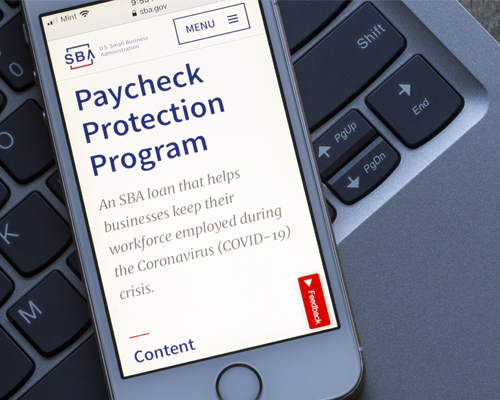It took months, several failed stops and starts, and nearly derailed the winter holidays, but the bipartisan, bicameral $900B Consolidated Appropriations Act 2021 (aka the stimulus bill) finally passed in late 2020. So how can you apply for some federal aid?
Paycheck Protection Program 2
Perhaps most anticipated program for our industry is the renewal of the Paycheck Protection Program (PPP) with a $284.45 billion in lending to eligible businesses (Congress also appropriated $20 billion for the EIDL grant program). Like the first round, the PPP loan requires no collateral or no personal guarantees. Again, PPP forgiveness is based on the 60/40 rule—60 percent of the loan is used for employee salaries with the remaining 40 percent going to other expenses. Otherwise, it qualifies as a loan with a 1-percent interest rate with 5-year maturity.

Applications for PPP are again being handled through qualified lenders through March 31, 2021, and is open to businesses that did and did not apply for a first round. However, you must have spent the full amount of the first PPP on eligible expenses to be considered for the second draw—but somehow we don’t think this will be an issue for the majority of operators as it’s been a LONG few months. If you’re not doing so already, get with your lender so you can apply ASAP.
We’ve included some guidelines from the SBA website below, but you can also get some real-time assistance about the second draw off PPP funds during the National Limousine Association’s webinar on Thursday, January 21, at 12:00 p.m. ET on the association’s Facebook page.
Additional SBA guidance:
- Applicants must have no more than 300 employees per location (there are additional rules for businesses with multiple locations that are their own separate entities)
- Must show a 25 percent revenue reduction (“gross receipts”) in 2020 relative to 2019 gross receipts using one quarter in 2020 versus the corresponding quarter in 2019
- Alternatively, a borrower that was in operation all four quarters of 2019 can use an annual reduction of 25+ percent in 2020 versus annual gross receipts 2019 to prove need, using annual tax forms
- Any forgiveness amount from first draw PPP in 2020 is excluded from gross receipts; PPP forgiveness amounts are excluded from being taxed as income
- Payroll cost calculation: Equal or lesser to 2.5 months of borrower’s average monthly payroll up to $2 million using the 12-month period prior to when loan is made (2020) or calendar year 2019
- If you used calendar year 2019 to calculate payroll for first PPP AND you use the same lender, you won’t need any additional documentation for the second draw application
- For loans with principal amount greater than $150K: Applicant must also submit documentation to prove 25 percent reduction in revenue at time of application
- For loans below $150K: Documentation of 25 percent revenue reduction is not required with application, but will be required on or before an application for forgiveness is filed
CERTS Act
Another industry benefit of the stimulus bill is the inclusion of the hard-fought CERTS Act, which will provide some dire financial relief specifically to the long-suffering (and largely ignored) motorcoach industry. CERTS will distribute more than $2 billion in aid to over-the-road bus companies, private school bus services, and U.S. flagged passenger vessels (cruise ships)—down from the hoped $10 billion. It now resides with the Treasury for program implementation, so the program won’t be accepting applications likely before February or March. However, a last-minute change to the Act has made the CERTS monies a 100 percent grant. Motorcoach operators need to follow 60/40 rule similar to that of the PPP: 60 percent of the money must go toward payroll, which can be distributed over 12 months as business ramps up. The remaining 40 percent is useable toward building rent/lease, insurance, and the interest on equipment loans. The program also guarantees equal access to small businesses, with an eye out for woman- and minority-owned motorcoach businesses.
Section 7(a) Loan and 504 Microloans
U.S. operators looking for more government money may be able to take advantage of two additional programs. Section 7(a) loan, is a loan that can be used for working capital, equipment, inventory, and business acquisitions (hey, that might come in handy, right?). Facilitated through an SBA lender, with loan maturities between 7 and 25 years, eligible candidates can borrow up to $5 million at both fixed and variable interest rates as long as you have fewer than 500 employees and less than $7.5 million in average annual receipts. You also must not be delinquent on any debt owed to the government.
Also available from the SBA is a 504 Microloan program, which is really designed to kickstart economic development and job creation with the purchase or real estate and equipment for your business. These loans also have a $5 million limit and have similar requirements, with fixed interest rates and maturation rates of 10-20 years.
Perhaps, best of all, the SBA is forgiving up to eight months of principal and interest payments on Section 7(a) and 504 Microloans.
As this is just an overview, and these various programs are all very nuanced, be sure to consult your financial guru to see which programs will be best for your business.
A special thank you to Strategy Leaders and Windels Marx for additional information.
[01.19.21]

